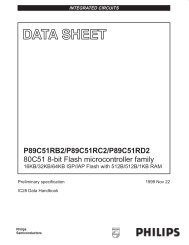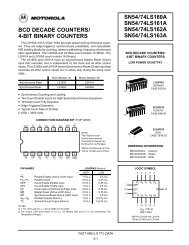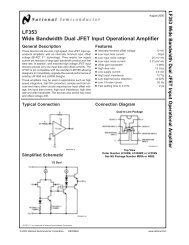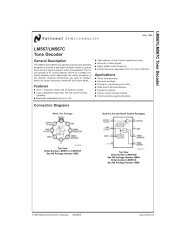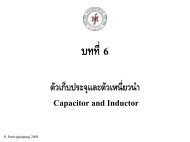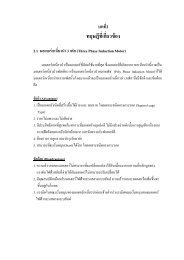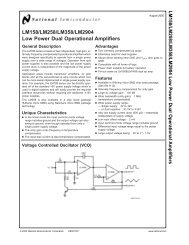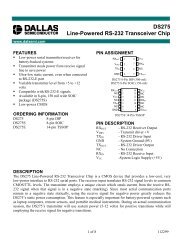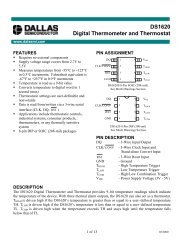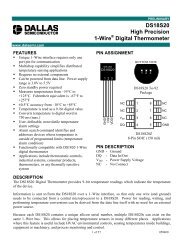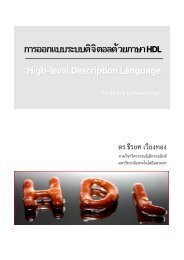tracking notch filter for electrocardiograph measurement
tracking notch filter for electrocardiograph measurement
tracking notch filter for electrocardiograph measurement
You also want an ePaper? Increase the reach of your titles
YUMPU automatically turns print PDFs into web optimized ePapers that Google loves.
TRACKING NOTCH FILTER FOR ELECTROCARDIOGRAPH MEASUREMENTS. WitthayapraditFaculty of EngineeringKing Mongkut’s Institute ofTechnology LadkrabangBangkok, 10520 Thailandemail: zsuriya@gmail.comS. ChitwongFaculty of EngineeringKing Mongkut’s Institute ofTechnology LadkrabangBangkok, 10520 Thailandemail: kcsakrey@kmitl.ac.thS. TumthongFaculty of Science and TechnologyRajamangala University of TechnologySuvarnabhumi, Nonthaburi CampusNonthaburi, 11000 Thailandemail: suwut@rmutsb.ac.thAbstractThis paper presents a <strong>tracking</strong> <strong>notch</strong> <strong>filter</strong> with opened-looparchitecture <strong>for</strong> elimination of electric field frequency whichcan also interfere into ECG wave<strong>for</strong>m. For measuring ECGwave<strong>for</strong>m having the isolated instrumentation amplifier, athere, the quality factor (Q) of this <strong>filter</strong> is assigned about 8 andthe attenuation of frequency noise is around of –35 dB and thegain of amplifier is of 1000. The frequency from frequencynoise detector is multiplied by the frequency synthesizer. Theclock signal from the frequency synthesizer is used <strong>for</strong> theswitched capacitor network. The per<strong>for</strong>mance of the proposed<strong>filter</strong> is tested with ECG wave<strong>for</strong>m included frequency noise of50Hz , 55Hz and 60Hz and also with measuring in Lead I ofbipolar lead included noise signal of 50Hz <strong>for</strong> both cases, thatis, be<strong>for</strong>e and after through the <strong>notch</strong> <strong>filter</strong> circuit in the timeand frequency domain. The measured results have beensuccessfully tested. In this paper, the discrete and passivedevices are used <strong>for</strong> the designed circuit.Keywords: ECG; Tracking <strong>notch</strong> <strong>filter</strong>; Line <strong>filter</strong>.1. IntroductionFirst, the <strong>tracking</strong> <strong>notch</strong> <strong>filter</strong> utilizes sequential phasefrequencydetector−S-PFD, band pass <strong>filter</strong>, summingamplifier, multiplication, integrator, and voltage controlledoscillator−VCO as important components [1]. Second,switched-capacitor adaptive sample-rate <strong>filter</strong>−SC-ASRFwhich is consisted of band pass <strong>filter</strong>, high pass <strong>filter</strong>, summingamplifier, multiplication, integrator, and VCO is used [2]. Bothmentioned methods are used as closed loop and also largecircuit. For this paper, <strong>tracking</strong> <strong>notch</strong> <strong>filter</strong> is used as open loopand noise frequency is introduced <strong>for</strong> frequency synthesizer.The designed <strong>tracking</strong> <strong>notch</strong> <strong>filter</strong> is then small circuit which isconsisted of switched-capacitor network−SCN and frequencysynthesizer to <strong>filter</strong> out noise in ECG signal shown in Fig.1.This paper is organized as following. In section 2, thedesigned <strong>tracking</strong> <strong>notch</strong> <strong>filter</strong> is represented and described. Theexperiments and results together with conclusions are given insection 3 and 4, respectively.V ECG+ V noisef noiseIsolated Amp.f - Noise ReferenceSC - NetworkPhase Lock LoopFREQ. - DividerFig. 1. Diagram of <strong>tracking</strong> <strong>notch</strong> <strong>filter</strong>.2. Design of Tracking Notch Filter2.1. The 4-Order Band Stop FilterIn this paper, integrated circuit as MAX263 which operateas switched-capacitor network is selected <strong>for</strong> band stop <strong>filter</strong>shown in Fig. 2. The characteristics of band stop <strong>filter</strong> consistof center frequency f o , quality factor Q which are set by logic,and attenuation. The structure of integrated circuit consists ofthe two 2-order band stop <strong>filter</strong>. Each is connected in series,the order of series connected band stop <strong>filter</strong> is then of 4 andalso the maximum attenuation is of -40dB.INPUTfromISO175+Vcc25V.GND2-Vss25V.+V cc25V.-Vss25V.1019GND18C270 .1uFV+V-54 1INA N/HPA INBMAX263Pin ProgramableF4 F3 F2 F1 F0 Q6 Q5 Q4 Q3 Q2 Q1 Q0 M0 M 111 12 23 17 24 9 6 25 22 21 16 15 8 726N/HPBCLKCLKACLKB1413clkOUTPUTFig. 2. Switched capacitor band-stop <strong>filter</strong>.2.2.1 Center frequency. It is adjusted to track noisefrequency. Equation [1] is used to assign center frequency. Athere, ration is of 150 times, that is, the input logic F4-F0 ofintegrated circuit band stop <strong>filter</strong> is 10000. Adjustment of thecenter frequency from 40Hz to 70Hz corresponds with theclock frequency from 6kHz to 10.5kHz.fclkN = [1]foV outwhere N is ratio, f clkclock frequency, and f ocenterfrequency.1-4244-0038-4 2006 IEEECCECE/CCGEI, Ottawa, May 2006187
2.2.2 Quality factor. The band width of band stop <strong>filter</strong> isdependent on quality factor and center frequency as equation[2]. The quality factor is of 8 by which input logic Q6-Q0 ofintegrated circuit band stop <strong>filter</strong> is 1111000.electrode on right hand, and GND1 is connected to electrodeon left leg.ALISO175+Isolation barrierf oQ = [2]BWRGVoutwhere Q is quality factor and BW bandwidth of band stop<strong>filter</strong>.2.2. Frequency SynthesizerFunction of frequency synthesizer is multiplying inputfrequency, 40Hz to 70Hz, from noise frequency detector into6kHz to 10.5kHz as clock frequency <strong>for</strong> controlling switchedcapacitor.As mentioned, the multiplication ratio is then of 150times. Frequency synthesizer circuit consists of phase lockloop by which the minimum and maximum frequency ofvoltage control oscillator is as equation [3] and frequencydivider shown in Fig. 3.11fmin=and fmax=[3]R ( C + 32pF)R ( C + 32pF)R2Fnoi seC28330 pFR12 11 1CLK+ V cc25V.+Vcc2+V cc25V .5V.16 411 135 162 163O/ PLOAD RCO D/UEN Q0144PCAin1CLK Q15PCBin 312 MA X/CLK 14Q27C1BMIN 74LS191CD4518 6Q313PC2out+Vcc2P3 P2 P1 P06R6 R7 CTEN5V.C1ARES GND1M 100 K94 8 9 10 1 1512 VCOinR8 R9 R10 R117 8R2C2910 K 10K 10K 10 K2.2 uFGND211 MC14046R116 V.INH GND5 8Fig. 3. Frequency synthesizer.2.3. Noise Frequency DetectorInducing of electric field via signal cable is used to detectnoise frequency as input signal <strong>for</strong> voltage comparator.Hysteresis comparator shown in Fig. 4 is implemented asvoltage comparator by which ranging of transition voltage isassigned as equation [4]R2V = upper[ Vout(max)]R + R+R2and V = lower[ Vout(max)]R + R− [4]1 2VinR1Vout1 2ARVS1+ VS1- GND1 VS2+ VS2- GND2Fig. 5. Isolated instrument amplifier.3. Experiments and Results3.1. Band Stop FilterEach of the clock frequency of 7.5kHz, 8.25kHz and9.0kHz, respectively, is fed to band stop <strong>filter</strong>. Let input signalbe sinusoidal wave<strong>for</strong>m, whose amplitude and frequency are of1Vp-p and of 10Hz to 100Hz. Output signals are measured andrecorded and the frequency response is then plotted as Fig. 6.From Fig. 6, that is, the clock frequency of 7.5kHz, 8.25kHzand 9.0kHz correspond with center frequency of 50Hz, 55Hzand 60Hz, respectively.Fig. 6. Frequency response of band-stop <strong>filter</strong>.3.2. Frequency SynthesizerAs mentioned, let the multiplication ratio be 150 times. Theinput signal frequency from noise frequency detector as theclock frequency ranging from 40Hz to 70Hz fed into frequencysynthesizer. The output signal frequency is measured andrelation between the input and output signal frequency isplotted as shown in Fig. 7 by which data1 means the data fromexperiment and data2 means the data from calculation. We seethat the relation between the input and output signal frequencyis linear enough.R2Fig. 4. Hysteresis comparator.2.4. Isolated Instrument AmplifierTo amplify ECG wave<strong>for</strong>m having amplitude of 1mVapproximately, isolated instrument amplifier is applied andgain is of 1000 times. At here, we selected the integratedcircuit as ISO175 of Burr-Brown shown in Fig. 5. AL input isconnected to electrode on left hand, AR input is connected toFig. 7. Relation of input and output frequency.188
3.3. Filtering with Noise Frequency addedStandard ECG Wave<strong>for</strong>mTo <strong>filter</strong> the noise frequency at each frequency, noisefrequency detector, frequency synthesizer, isolated instrumentamplifier and 4-order band stop <strong>filter</strong> are connected as the<strong>tracking</strong> <strong>notch</strong> <strong>filter</strong>. By using MATLAB program, thestandard ECG wave<strong>for</strong>m [3], whose amplitude is of 1.2Vshown in Fig. 8, is created and added by noise signal. Thenoise added standard ECG wave<strong>for</strong>m is conversed <strong>for</strong>BenchLink program in order to download onto arbitrarygenerator of HP33120A which generate real ECG signal shownin Fig. 9.(c)Fig. 10. Spectral from analyzing by using MATLAB.To confirm result in term of MSE, the standard ECGwave<strong>for</strong>m from Fig. 8 and the <strong>filter</strong>ed ECG wave<strong>for</strong>m fromFig. 9 which is recorded by WAVESTAR program, bothshown together in Fig. 11 by which dot line is the standardECG wave<strong>for</strong>m and solid line is the <strong>filter</strong>ed ECG wav<strong>for</strong>m, areused to calculate MSE. The MSE is of 3.44%.Fig. 8. The standard ECG wave<strong>for</strong>m [3].From Fig. 9, signal No. 3 is the standard ECG signalwhose amplitude is of 1V and period is of 1ms. Signal No.1 isthe noise added standard ECG signal by which amplitude andfrequency of noise is of 200mV and 50Hz, respectively. SignalNo.2 is the <strong>filter</strong>ed ECG signal from the <strong>tracking</strong> <strong>notch</strong> <strong>filter</strong>.3 >1 >TTFig. 11. Comparison between Standard and Filtered ECG.For other experiment, let noise frequency be of 55Hz and60Hz. The experiment is per<strong>for</strong>med the same as in case ofnoise frequency of 50Hz. Results of <strong>filter</strong>ing noise frequencyof 55Hz show in Fig. 12 to 14. Fig. 13(b) shows that spectral ofthe <strong>filter</strong>ed ECG signal at frequency of 55Hz is eliminatedwhen comparing with Fig. 13(a). The MSE is of 2.34%.2 >T1) Ch 1: 500 mV 250 ms2) Ch 2: 500 mV 250 ms3) Ref 1: 500 mV 250 msFig. 9. Real ECG wave<strong>for</strong>m, upper: standard ECG [3]Middle: ECG combined with noise frequency of 50Hz.Lower: Filtered ECG.1 >2 >TTAlso we use WAVESTAR program to record the real ECGwave<strong>for</strong>m <strong>for</strong> analyzing spectral by using MATLAB program.Fig. 10 shows all spectral of real ECG signal correspondingwith signal shown in Fig. 9. From Fig. 10(c), see that spectralof the <strong>filter</strong>ed ECG signal at frequency of 50Hz is eliminated.1) Ch 1: 500 mV 250 ms2) Ch 2: 500 mV 250 msFig. 12. Upper: ECG combined with noise frequency of 55Hz.Lower: Filtered ECG.(a)(b)(a)(b)Fig. 13. Spectral from analyzing by MATLAB.189
1 >TFig. 14. Comparison between standard and <strong>filter</strong>ed ECG.Results of <strong>filter</strong>ing noise frequency of 60Hz show in Fig.15 to 17. Fig. 16(b) shows that spectral of the <strong>filter</strong>ed ECGsignal at frequency of 60Hz is eliminated when comparingwith Fig. 16(a). The MSE is of 1.44%.1) Ch 1: 500 mV 250 ms(a)(b)Fig. 18. (a) Un<strong>filter</strong>ed ECG (b) its Spectral.1 >T1 >T1) Ch 1: 500 mV 250 ms(a)(b)Fig. 19. (a) Filtered ECG (b) its Spectral.2 >T1) Ch 1: 500 mV 250 ms2) Ch 2: 500 mV 250 msFig. 15. Upper: ECG combined with noise frequency of 60Hz.Lower: Filtered ECG.(a)(b)Fig. 16. Spectral from analyzing by MATLAB.Fig. 17. Comparison between Standard and Filtered ECG.3.4. Filtering with Real ECG SignalUsing electrode as standard position to measure ECG signal inlead I, such ECG signal is connected to the isolated instrumentamplifier and output signal from one is fed to the designed<strong>tracking</strong> <strong>notch</strong> <strong>filter</strong>. The un<strong>filter</strong>ed and <strong>filter</strong>ed ECGwave<strong>for</strong>m is measured and recorded by WAVESTAR program.Fig. 18(a) and (b) show the un<strong>filter</strong>ed ECG wave<strong>for</strong>m and itsspectral, respectively. Also, Fig. 19(a) and (b) show the <strong>filter</strong>edECG wave<strong>for</strong>m and its spectral, respectively. Comparing Fig.18 and 19 shows that the designed <strong>tracking</strong> <strong>notch</strong> <strong>filter</strong> can<strong>filter</strong> out the noise frequency seeing in both time and frequencydomain.4. ConclusionsFrom frequency response of the designed <strong>tracking</strong> <strong>notch</strong><strong>filter</strong>, attenuation at each center frequency is approximately of-35dB to -38dB which is good enough. The difference of thecalculated and measured frequency from frequency synthesizer<strong>for</strong> which the multiplication is of 150 times is very close. Theper<strong>for</strong>mance by experiment with the noise frequency addedstandard ECG wave<strong>for</strong>m have shown the <strong>filter</strong>ed ECGwave<strong>for</strong>m in time domain without noise, frequency domainwithout spectral of noise frequency, and in term of MSE seeingthat it is low enough. Also, the per<strong>for</strong>mance of the real ECGsignal has shown the <strong>filter</strong>ed ECG wave<strong>for</strong>m in time domainwithout noise and in frequency domain without spectral ofnoise frequency, only.One of advantage of the designed <strong>tracking</strong> <strong>notch</strong> <strong>filter</strong> is thesmall circuit size when comparing with the closed loop bandstop <strong>filter</strong> and can use discrete component and passive device.In future, this <strong>filter</strong> will develop as a single chip.References[1] L. Bustamante and M. A. Soderstrand, “High-RangSwitched Capacitor Tracking,” IEEE InternationalSymposium on Circuits and Systems , vol. 1, pp. 688-691,May, 1999.[2] L. Bustamante, R. H. Strandberg, and M. A. Soderstrand,“Switched-Capacitor Adaptive Sampling Rate Notch Filter<strong>for</strong> Enhancement and Elimination of Bandpass Signal,”Proceeding Of the 40 th Midwest Symposium on Circuitsand System, vol. 2, pp. 1354-1357, August, 1997.[3] P. E. McSharry, G. D. Clif<strong>for</strong>d, L. Tarassenko, and L. A.Smith, “A Dynamical Model <strong>for</strong> Generating SynthesisElectrocardiogram Signals,” IEEE Trans. On BiomedicalEngineering, vol. 50, no. 3, pp. 289-294, March, 2003.190


